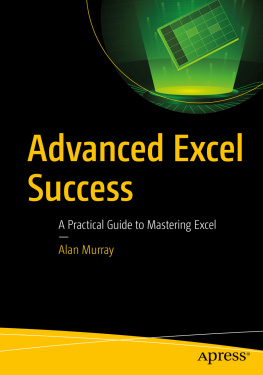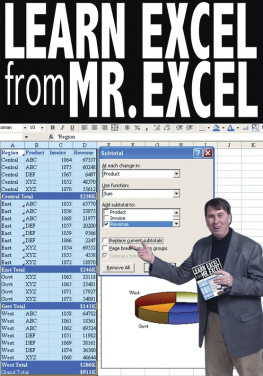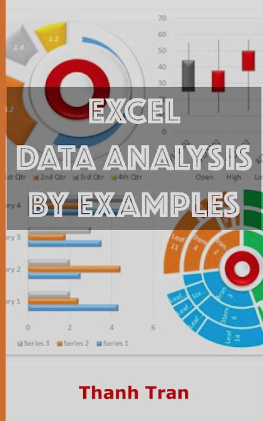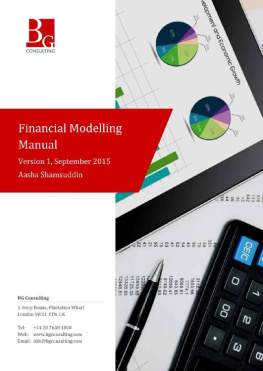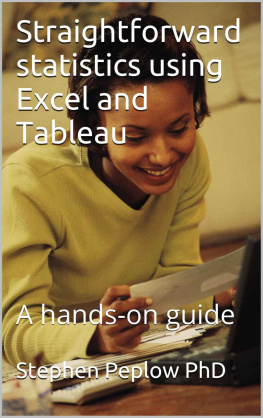Bellini - How to Model and Validate Expected Credit Losses for IFRS9 and CECL : A Practical Guide with Examples Worked in Excel, R, and SAS.
Here you can read online Bellini - How to Model and Validate Expected Credit Losses for IFRS9 and CECL : A Practical Guide with Examples Worked in Excel, R, and SAS. full text of the book (entire story) in english for free. Download pdf and epub, get meaning, cover and reviews about this ebook. City: San Diego, year: 2019, publisher: Elsevier Science & Technology, genre: Romance novel. Description of the work, (preface) as well as reviews are available. Best literature library LitArk.com created for fans of good reading and offers a wide selection of genres:
Romance novel
Science fiction
Adventure
Detective
Science
History
Home and family
Prose
Art
Politics
Computer
Non-fiction
Religion
Business
Children
Humor
Choose a favorite category and find really read worthwhile books. Enjoy immersion in the world of imagination, feel the emotions of the characters or learn something new for yourself, make an fascinating discovery.

- Book:How to Model and Validate Expected Credit Losses for IFRS9 and CECL : A Practical Guide with Examples Worked in Excel, R, and SAS.
- Author:
- Publisher:Elsevier Science & Technology
- Genre:
- Year:2019
- City:San Diego
- Rating:5 / 5
- Favourites:Add to favourites
- Your mark:
- 100
- 1
- 2
- 3
- 4
- 5
How to Model and Validate Expected Credit Losses for IFRS9 and CECL : A Practical Guide with Examples Worked in Excel, R, and SAS.: summary, description and annotation
We offer to read an annotation, description, summary or preface (depends on what the author of the book "How to Model and Validate Expected Credit Losses for IFRS9 and CECL : A Practical Guide with Examples Worked in Excel, R, and SAS." wrote himself). If you haven't found the necessary information about the book — write in the comments, we will try to find it.
Bellini: author's other books
Who wrote How to Model and Validate Expected Credit Losses for IFRS9 and CECL : A Practical Guide with Examples Worked in Excel, R, and SAS.? Find out the surname, the name of the author of the book and a list of all author's works by series.
How to Model and Validate Expected Credit Losses for IFRS9 and CECL : A Practical Guide with Examples Worked in Excel, R, and SAS. — read online for free the complete book (whole text) full work
Below is the text of the book, divided by pages. System saving the place of the last page read, allows you to conveniently read the book "How to Model and Validate Expected Credit Losses for IFRS9 and CECL : A Practical Guide with Examples Worked in Excel, R, and SAS." online for free, without having to search again every time where you left off. Put a bookmark, and you can go to the page where you finished reading at any time.
Font size:
Interval:
Bookmark:

First edition
Tiziano Bellini

- Tables in Chapter 1
- Tables in Chapter 2
- Tables in Chapter 3
- Tables in Chapter 4
- Tables in Chapter 5
- Tables in Chapter 6
- Figures in Chapter 1
- Figures in Chapter 2
- Figures in Chapter 3
- Figures in Chapter 4
- Figures in Chapter 5
- Figures in Chapter 6
Academic Press is an imprint of Elsevier
125 London Wall, London EC2Y 5AS, United Kingdom
525 B Street, Suite 1650, San Diego, CA 92101, United States
50 Hampshire Street, 5th Floor, Cambridge, MA 02139, United States
The Boulevard, Langford Lane, Kidlington, Oxford OX5 1GB, United Kingdom
Copyright 2019 Elsevier Inc. All rights reserved.
No part of this publication may be reproduced or transmitted in any form or by any means, electronic or mechanical, including photocopying, recording, or any information storage and retrieval system, without permission in writing from the publisher. Details on how to seek permission, further information about the Publisher's permissions policies and our arrangements with organizations such as the Copyright Clearance Center and the Copyright Licensing Agency, can be found at our website: www.elsevier.com/permissions.
This book and the individual contributions contained in it are protected under copyright by the Publisher (other than as may be noted herein).
Notices
Knowledge and best practice in this field are constantly changing. As new research and experience broaden our understanding, changes in research methods, professional practices, or medical treatment may become necessary.
Practitioners and researchers must always rely on their own experience and knowledge in evaluating and using any information, methods, compounds, or experiments described herein. In using such information or methods they should be mindful of their own safety and the safety of others, including parties for whom they have a professional responsibility.
To the fullest extent of the law, neither the Publisher nor the authors, contributors, or editors, assume any liability for any injury and/or damage to persons or property as a matter of products liability, negligence or otherwise, or from any use or operation of any methods, products, instructions, or ideas contained in the material herein.
Library of Congress Cataloging-in-Publication Data
A catalog record for this book is available from the Library of Congress
British Library Cataloguing-in-Publication Data
A catalogue record for this book is available from the British Library
ISBN: 978-0-12-814940-9
For information on all Academic Press publications visit our website at https://www.elsevier.com/books-and-journals

Publisher: Candice Janco
Acquisition Editor: Scott Bentley
Editorial Project Manager: Susan Ikeda
Production Project Manager: Bharatwaj Varatharajan
Designer: Mark Rogers
Typeset by VTeX
A mio pap, ad un eroe silenzioso, alla sua encomiabile moralit.
Tiziano Bellini received his PhD degree in statistics from the University of Milan after being a visiting PhD student at the London School of Economics and Political Science. He is a Qualified Chartered Accountant and Registered Auditor. He gained wide risk management experience across Europe (including in London) and in New York. He is currently Director at BlackRock Financial Market Advisory (FMA) in London. Previously he worked at Barclays Investment Bank, EY Financial Advisory Services in London, HSBC's headquarters, Prometeia in Bologna, and other leading Italian companies. He is a guest lecturer at Imperial College in London, and at the London School of Economics and Political Science. Formerly, he served as a lecturer at the University of Bologna and the University of Parma. Tiziano is the author of Stress Testing and Risk Integration in Banks, A Statistical Framework and Practical Software Guide (in Matlab and R) edited by Academic Press. He has published in the European Journal of Operational Research, Computational Statistics and Data Analysis, and other top-reviewed journals. He has given numerous training courses, seminars, and conference presentations on statistics, risk management, and quantitative methods in Europe, Asia, and Africa.
Tiziano Bellini
A series of concerns have been expressed since the adoption of the incurred losses paradigm by both the International Accounting Standard Board (IASB) and the Financial Accounting Standard Board (FASB). The recent (20072009) financial crisis uncovered this issue by inducing a review of accounting standards which culminated with the International Financial Reporting Standard number 9 (IFRS 9) and Current Expected Credit Loss (CECL).
This book provides a comprehensive guide on credit risk modelling and validation for IFRS 9 and CECL expected credit loss (ECL) estimates. It is aimed at graduate, master students and practitioners. As a distinctive practical imprint, software examples in R and SAS accompany the reader through the journey. The choice of these tools is driven by their wide use both in banks and academia.
Despite the non-prescriptive nature of accounting standards, common practice suggests to rely on the so-called probability of default (PD), loss given default (LGD), and exposure at default (EAD) framework. Other non-complex methods based on loss-rate, vintage, cash flows are considered as a corollary. In practice, banks estimate their ECLs as the present value of the above three parameters' product over a one-year or lifetime horizon. Based on this, a distinction arises between CECL and IFRS 9. If the former follows a lifetime perspective for all credits, the latter classifies accounts in three main buckets: stage 1 (one-year ECL), stage 2 (lifetime ECL), stage 3 (impaired credits). The key innovation introduced by the new accounting standards subsumes a shift towards a forward-looking and lifetime perspective. Therefore a link between macroeconomic variables (MVs), behavioural variables (BVs), and the above three parameters is crucial for our dissertation. Such a framework is also a natural candidate for stress testing projections.
From an organizational standpoint, Chapter serves the purpose to introduce IFRS 9 and CECL. It points out their similarities and differences. Then the focus is on the link connecting expected credit loss estimates and capital requirements. A book overview is provided as a guide for the reader willing to grasp a high-level picture of the entire ECL modelling and validation journey.
Chapter focuses on one-year PD modelling. Two main reasons suggest our treating one-year and lifetime separately. Firstly, banks have been developing one-year PD models over the last two decades for Basel II regulatory requirements. Secondly, a building-block-structure split in one-year and lifetime PD facilitates the learning process. As a starting point, this chapter focuses on how default events are defined for accounting purposes and how to build a consistent PD database. Moving towards modelling features, firstly, generalized linear models (GLMs) are explored as a paradigm for one-year PD estimates. Secondly, machine learning (ML) algorithms are studied. Classification and regression trees (CARTs), bagging, random forest, and boosting are investigated both to challenge existing models, and explore new PD modelling solutions. In line with the most recent literature, the choice of these approaches is driven both by their effectiveness and easy implementation. If a wide data availability encourages the use of data driven methods, low default portfolios and data scarcity are other challenges one may need to face. Bespoke methods are scrutinized to address issues related to limited number of defaults, and ad hoc procedures are explored to deal with lack of deep historical data.
Font size:
Interval:
Bookmark:
Similar books «How to Model and Validate Expected Credit Losses for IFRS9 and CECL : A Practical Guide with Examples Worked in Excel, R, and SAS.»
Look at similar books to How to Model and Validate Expected Credit Losses for IFRS9 and CECL : A Practical Guide with Examples Worked in Excel, R, and SAS.. We have selected literature similar in name and meaning in the hope of providing readers with more options to find new, interesting, not yet read works.
Discussion, reviews of the book How to Model and Validate Expected Credit Losses for IFRS9 and CECL : A Practical Guide with Examples Worked in Excel, R, and SAS. and just readers' own opinions. Leave your comments, write what you think about the work, its meaning or the main characters. Specify what exactly you liked and what you didn't like, and why you think so.


